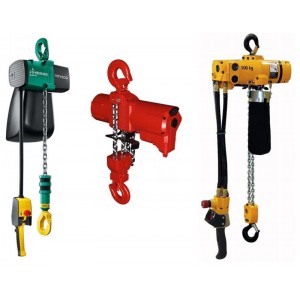Hoists and hoisting equipment make up one of the largest categories of our lifting equipment. Within this fairly large category are sub-categories, with dozens of items and gear included. For this reason, it can often be hard filtering down between the equipment, and deciding which is best for your operation. So, here we have laid out a bitesize article on air hoists.
The quick air hoist definition
Before getting into some of the more specific features and benefits of an air hoist, we want to offer a quick definition of this equipment. Essentially, these are lifting mediums used to hoist loads up, or lower them down. They are powered pneumatically, which means that they use an air compressor unit as their source of power. This unit sucks in air from the atmosphere, removes moisture from it, and then pushes dry air through the pipes to then power the air hoist.
What are air hoists ? Air hoists use compressed air, such as that which you’ll find in these bottles. This is in contrast to manual hoists, which are operated manually by workers, and electric hoists, which run off of an electric power supply.
There are numerous brands and models of pneumatic air hoists with a variety of features to choose from. Browse the air hoist collection at Lifting Gear Direct to compare some of the best air hoists around.
The advantages of an air hoist
There are many advantages to using this type of equipment:
- They enable a powered lifting hoist to be used where using electricity is not an option.
- Typically, many varieties of this equipment enjoy a 100% duty cycle, which means that they don’t need any rest periods due to overheating
- They feature a simple design, so aren’t complicated to use! Thanks to this, they have a long service life, require very little maintenance and are much cleaner to operate with a low impact on the environment
- This simple design also means that they are lightweight and easily portable. They are typically around 40%-50% lighter than their electric hoist counterparts
- They have a very low fire risk, and offer a good level of resistance against things such as vapour, dust, dirt and humidity
- They are much less likely to experience any shock damage, given the fact that they use compressed air
- Safety braking systems come incorporated, keeping your load, your equipment and your workers safe
Where can you use Air powered lifting hoists?
So, if we take into consideration the above benefits, where can you use an air hoist? Firstly, thanks to their fairly compact and lightweight nature, they are easily portable around many worksites. And, offering strong lifting capabilities, they are useful for many types of lifting and lowering tasks. They are most commonly used on assembly lines, particularly in the aerospace, construction, engineering and shipping industries. Alongside this, given their extremely low fire risk, they can be used in hazardous environments. This is something that many electric hoists don’t benefit from given their risk of sparking. Such hazardous environments include places such as power and chemical plants, mines, and facilities that store oil.
Of course to use an air hoist you will need a consistent compressed air supply. If you have one then an air hoist will probably be cheaper to run than an electric equivalent.
Are you looking for more information?
We hope that the above article has been useful in explaining more on this handy piece of equipment. If you have further questions or would like to enquire about ordering your own air hoist, then we’d love to help. Please get in touch with us.
Posted On: January 15, 2018
